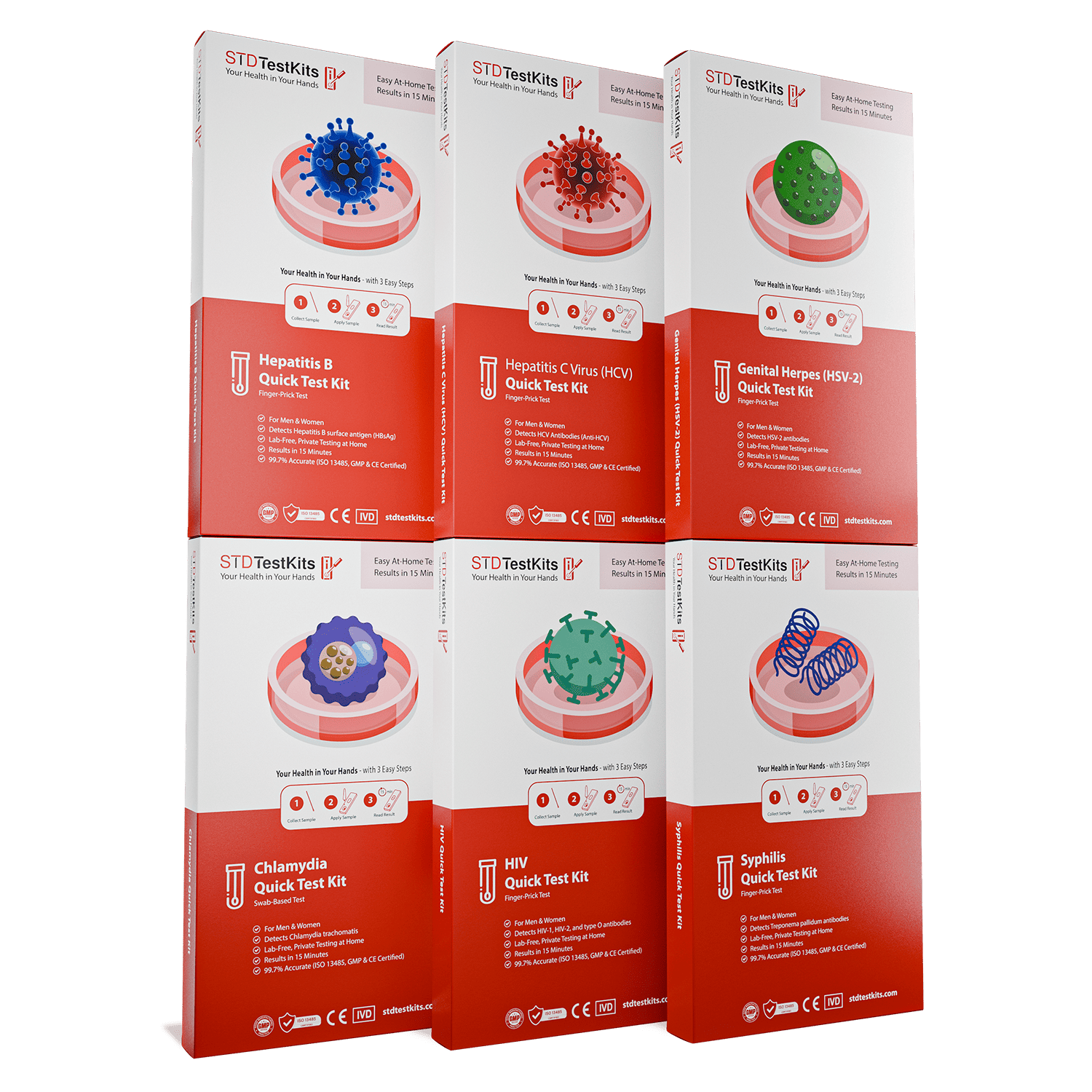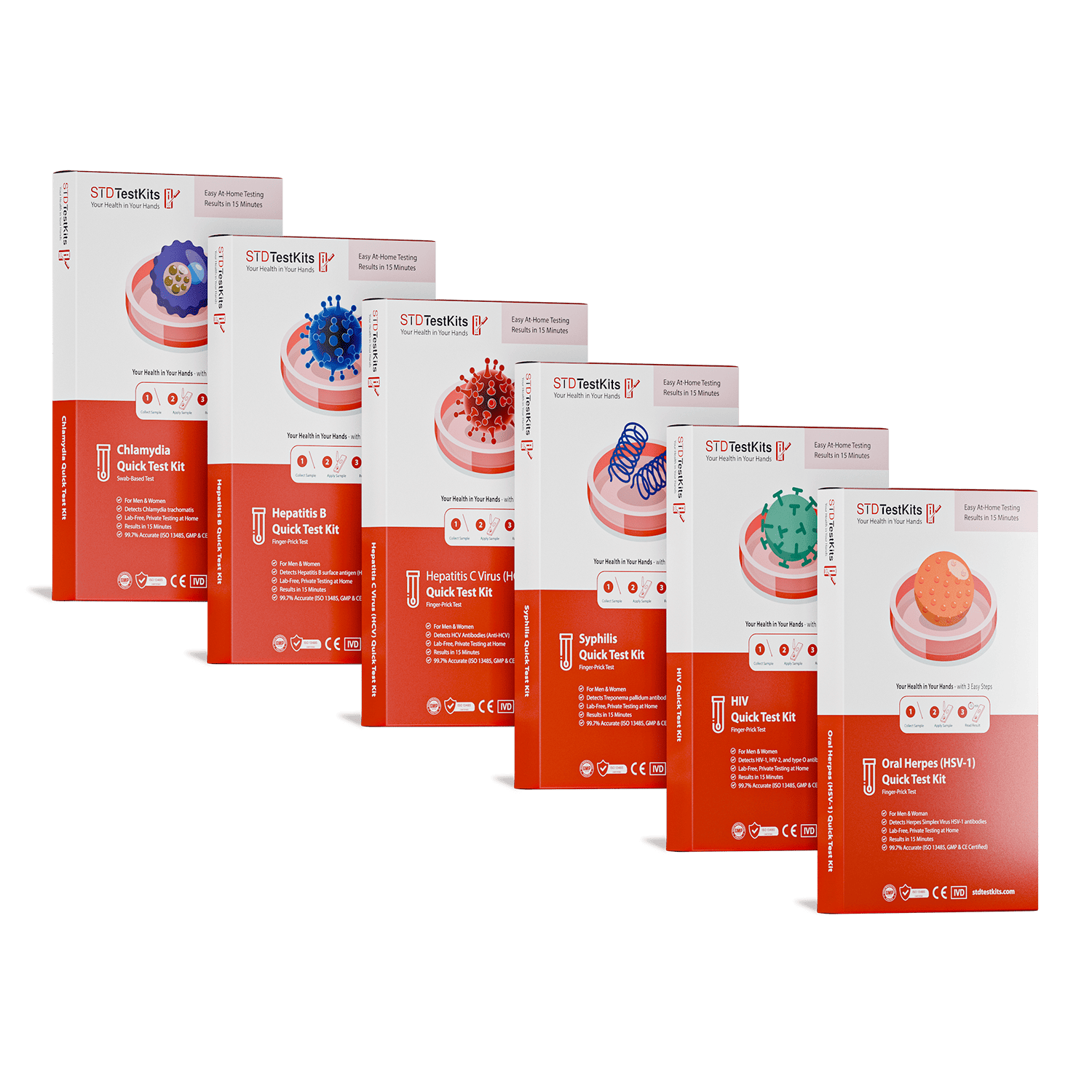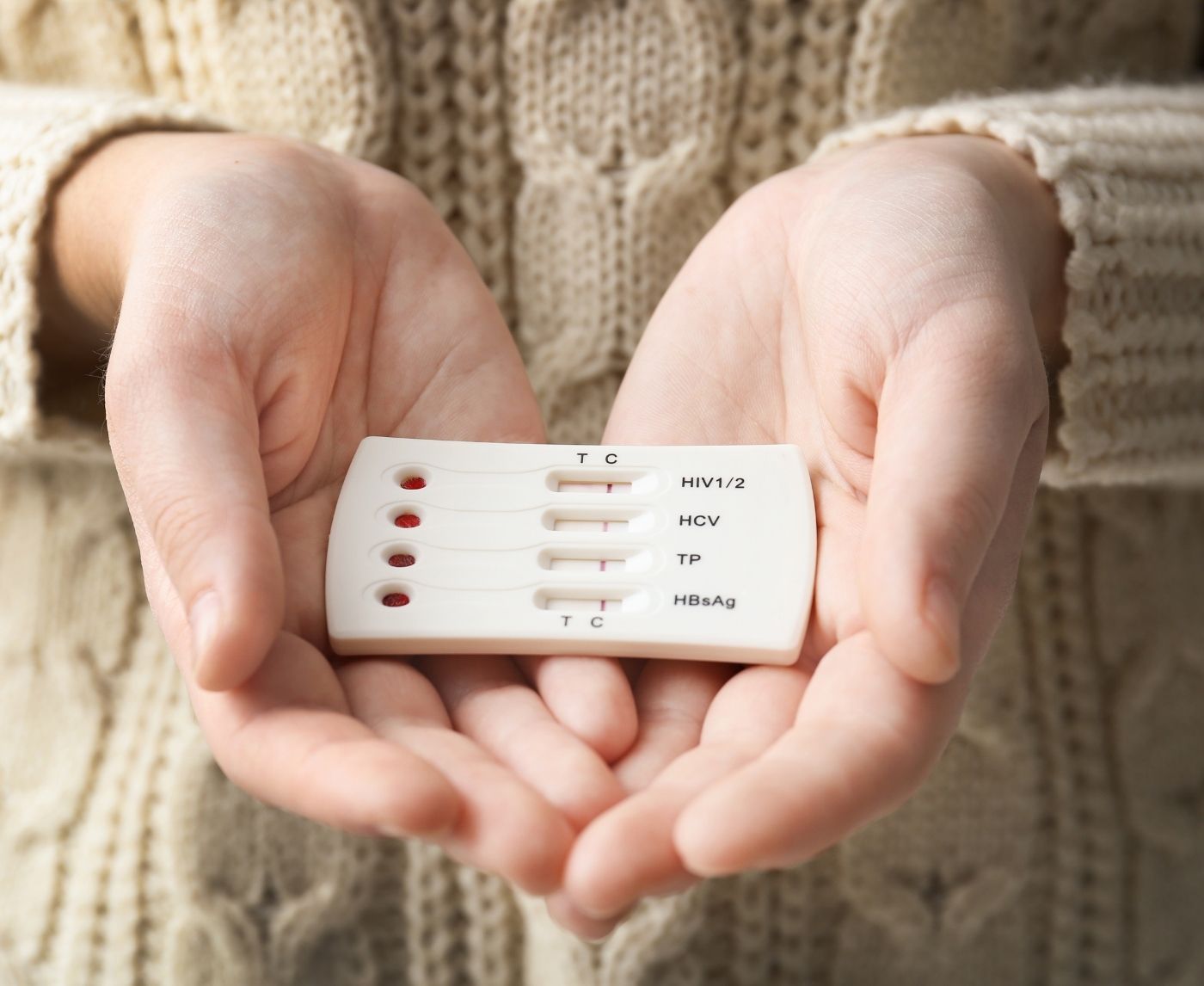How Accurate Is a Syphilis Rapid Test?
Quick Answer: The JECH article shows that even well-designed, whole-school sexual-health interventions may not significantly reduce risky sexual debut or STI/pregnancy outcomes. For at-home STD test kits, this reinforces their importance as a complementary strategy: schools can educate and promote safer sex, but home testing gives individuals agency, privacy, convenience and a critical safety net when broader prevention efforts don’t reach.
From Curriculum to Real Life: Why Education Alone Isn’t Enough
Picture this: You're sixteen, sitting in a classroom where the teacher awkwardly gestures at a diagram of genitals while half the room giggles and the other half pretends not to exist. The lesson talks about “choices,” “boundaries,” and “contraception”, but it doesn’t mention what happens when your partner refuses a condom. It doesn’t tell you what to do if you feel a weird burn three weeks later and you're too ashamed to ask your GP. It doesn’t give you a real-life plan when the anxiety creeps in at 2 a.m. That’s where most school programs hit a wall. They speak in theory. Real life is messier.
The Positive Choices study was ambitious. It embedded a school-wide approach meant to shift attitudes toward sex, boost communication, and empower students. It offered training, parent engagement, and student leadership, all admirable pieces. But statistically, it didn’t budge the needle. According to the trial results, there was no significant reduction in reported non-competent first sex or in unintended pregnancy risk behaviors. The data quietly says what sexual health workers have long known: You can build the best program in the world, but if it stops at the school gate, it won’t reach the bed, the clinic, or the test result that never gets read.
What the Study Didn’t Measure: Access, Fear, and Private Action
Take Ray, for instance. At 17, they’d sat through three years of RSE. But when they found an unfamiliar sore after a summer hookup, panic set in. It wasn’t a school counselor they turned to. It was their phone, late at night, googling “can you get herpes without symptoms” and “at-home STD test that’s private.” They ordered one the next morning from their shared flat, praying no one opened the envelope. Their school had talked about condoms, but never the reality of testing, especially if you didn’t feel sick or couldn’t tell your parents.
This kind of behavior, quiet, anxious, self-guided, isn’t captured in school trials. Nor is the delayed reaction: the kid who waits months, who pretends the symptom isn’t real, who finally tests after seeing a TikTok about STDs. The Positive Choices intervention was measured against student surveys and school reports, but sexual health decisions don’t happen inside a questionnaire. They happen in the gaps between shame, symptoms, and self-preservation. That’s why testing options matter. And that’s why at-home kits aren’t just a convenience, they’re a crucial bridge between knowledge and action.
Home STD Testing: A Growing Counterpart to School-Based Gaps
At-home STD tests are more than discreet packages, they’re permission slips for people who feel too scared, too unsure, or too embarrassed to walk into a clinic. And the rise in demand isn’t coincidence. It's a response to the very limitations studies like Positive Choices reveal. When school programs don't translate into behavior change, self-led tools pick up the slack.
The average user of an at-home kit isn’t necessarily someone who skipped sex ed. Often, it’s someone who got the lessons, but still found themselves exposed, confused, or too nervous to get tested in person. These are people navigating relationships, gender dynamics, hookups, or even coercion, things that a one-size-fits-all curriculum can't fully prepare them for. When that happens, being able to test privately, without needing to justify yourself, becomes its own form of care.
Figure 1. Comparison of STD testing settings highlighting accessibility challenges and advantages.

People are also reading: How Antibiotics Mess With Your Vagina, And What to Do About It
Testing Is More Than a Result, It’s a Turning Point
We often treat testing like a checkbox, something you do or don’t do. But for many, it’s more like a door. For people who grew up being told “nice girls don’t” or “real men don’t get sick,” testing can be an act of rebellion, of self-trust, of finally listening to their own gut instead of the myths they were handed. That’s especially true when it’s done in private. In the quiet of your own room. On your own terms.
The Positive Choices study might seem like a disappointment at first glance. But it actually opens the conversation wider. If school-based programs can't do it alone, what else must we offer? The answer is layered: yes, education; yes, communication; but also, direct tools. Test kits on shelves. Delivery options with no labels. Platforms that let someone test without ever speaking aloud the words “I think I might have an STD.”
It’s in those small, quiet moments that real health decisions happen. And it’s where real prevention, not just policy, takes root.
Waiting, Worrying, Retesting: The Unspoken Reality
Here’s what we don’t always say out loud: testing isn’t always a one-and-done. You might test negative today, breathe for the first time in days, then wake up a week later with a symptom that makes your stomach drop. This is where the science of window periods meets the psychology of fear. Most STDs have an incubation time, the period after exposure before a test can accurately detect them. That means a negative result too early can give false comfort. It also means that retesting, far from being redundant, is often the most responsible thing someone can do.
Ellie’s story illustrates this well. She had sex with someone new after college orientation and tested five days later, negative across the board. But ten days after that, she felt a burning sensation she couldn’t ignore. The second test, done on day fifteen, came back positive for chlamydia. Her first test wasn’t wrong. It was just early. And no one had told her that timing matters as much as the test itself.
Figure 2. Common STD window periods and when retesting is warranted for accuracy.
This is where at-home kits earn their place. You don’t need to explain to anyone why you’re testing again. You don’t need to book a second appointment or dodge uncomfortable glances at the clinic. You just click, test, and know. It’s healthcare on your terms, and when the clock matters, autonomy can be everything.
Privacy Isn’t a Perk, It’s the Whole Point
People often frame at-home testing as a modern convenience. But for many, it’s more than that. It’s survival. Imagine you’re 19, queer, living at home, and scared that coming out might mean losing everything. Or you’re in a controlling relationship where even searching for clinic info could trigger danger. Or you’re undocumented, uninsured, or just terrified of judgment. For these people, the idea of walking into a clinic isn’t brave, it’s impossible.
That’s why we talk so much about privacy. It’s not because someone is hiding something. It’s because in a world that still punishes certain bodies, certain desires, and certain identities, discretion is liberation. A brown box arriving in the mail could mean someone finally finds out they have herpes. It could also mean they finally stop blaming themselves for that sting they’ve been ignoring for months. At-home testing creates a quiet space for truth to emerge, without the noise of stigma or systems.
School Might Start the Conversation, But Home Testing Finishes It
Let’s be clear: school-based education matters. The Positive Choices study may not have shown measurable behavior change, but that doesn’t mean it failed entirely. For some students, those lessons are their first exposure to the language of consent, to the anatomy of protection, to the reality of risk. That knowledge can be foundational. But it’s not the final step. It’s a beginning, a script handed out in a controlled setting. Life, however, doesn’t follow that script.
Think about Kareem. He’d been through RSE, had condoms in his drawer, and even remembered the lesson on STI transmission. But when the condom broke and his partner panicked, his school hadn’t prepared him for that moment of frozen fear. He didn’t know where to go. Didn’t want to ask his dad. So he sat on it, for days, until a friend mentioned that they could test from home. That test gave him answers. That moment re-engaged him in his own health. It wasn’t a lesson plan. It was a lifeline.
Education gives you the map. Testing is what tells you where you really are.
The Bigger Picture: Empowerment Through Access
The takeaway from the JECH trial isn’t that school programs are useless. It’s that no single intervention can carry the weight of public health. Especially not when shame, silence, and system barriers still dominate the sexual health landscape. Real progress comes when multiple doors are open, when you don’t have to choose between a classroom and a clinic, but can access both. When information is paired with action. When privacy meets precision.
Home STD test kits aren’t a side tool. They’re part of the new frontline. They meet people where they are, digitally, emotionally, geographically. And they don’t just serve those who already know the risks. They reach the ones who fell asleep during sex ed, the ones who had no sex ed, the ones who thought they were safe because they “only did oral.” They offer a second chance. A next step. A real answer.
Whether the school succeeded or not, whether the curriculum was perfect or performative, testing gives the individual control. And in a world where sexual health still carries stigma, silence, and consequence, that kind of control is power.
What Happens When People Don’t Test: The Quiet Cost of Silence
When someone delays testing, the consequences rarely announce themselves right away. There’s no siren, no flashing red light. Sometimes there are no symptoms at all. Just a quiet progression, from untreated to complicated. That’s what happened to Jordan. At 22, he didn’t know he’d ever been exposed. His partner hadn’t known either. It wasn’t until a persistent ache in his lower back sent him to urgent care that a doctor finally diagnosed him with chlamydia, but not before it had triggered epididymitis, a painful inflammation of the testicles that could’ve been prevented with earlier care.
This is the hidden cost of inaccessible or intimidating testing. It's not just about feeling safe; it's also about stopping infections before they cause pelvic inflammatory disease, infertility, or long-term pain. These aren’t scare tactics; they’re real outcomes for people who feel too ashamed or overwhelmed to get tested in time. And while school programs may teach prevention, they rarely account for this stage, for the people who slip through the cracks and only come forward when damage has already begun.
With at-home kits, there’s an opportunity to catch infections quietly, privately, before they escalate. It’s not just a test. It’s a prevention tool. A turning point. A fork in the road where one direction leads to treatment and healing, and the other doesn’t.
Symptoms or No Symptoms, You Still Might Be Infected
One of the most dangerous myths around STDs is that you’ll know if you have one. That if you’re infected, something will feel “off.” The truth? Most people with chlamydia or gonorrhea don’t notice any symptoms at all. Neither do those newly infected with HIV or syphilis. In fact, by the time many people experience symptoms, the infection has already been in their system for weeks, if not months. That’s why routine testing, not just symptom-based panic, is so critical.
Maya (not her real name) had no reason to think anything was wrong. She was in a monogamous relationship. They used condoms. She felt fine. It wasn’t until she went in for a routine IUD check and agreed to a full panel “just to be safe” that she learned she’d been carrying trichomoniasis for months. No signs. No pain. Nothing obvious. The infection had passed back and forth between her and her partner multiple times without either of them knowing. The emotional fallout was brutal. But the test, the test gave her back the facts. The ability to act.
Stories like hers underscore why relying on symptoms alone is a mistake. And why at-home kits, especially for people who don’t feel “sick”, are a powerful safeguard against invisible infections.

People are also reading: Can You Take Wegovy or Ozempic If You Have HIV or Hep C?
Stigma Doesn’t Die in the Classroom
The JECH study may have focused on knowledge, intentions, and behavior, but it couldn’t quantify the thing that derails so many testing journeys: shame. It’s one thing to learn about condoms in a controlled school environment. It’s another to face the reality of needing a test, unsure if your partner lied, or if your one-night stand forgot to mention something. It’s another entirely to walk into a clinic in a town where your aunt works the front desk.
This is where the cultural side of sexual health plays out. And it’s where home testing wins. There’s no public waiting room. No judgmental intake forms. No sideways glances when you ask for a syphilis test. Just you, your test, and a choice about what to do next. That’s not just privacy. That’s dignity.
Some people will always prefer clinics or doctor consults, and that’s valid. But for the many who don’t, or can’t, at-home testing is an option that honors complexity. It meets people where they are, even if “where they are” is curled up in bed at 1:00 a.m., wondering if that rash means anything.
Knowledge Without Access Isn’t Empowerment
If there’s one lasting lesson from the Positive Choices study, it’s this: information alone doesn’t change behavior. Not if it’s not paired with access. You can tell a thousand teenagers about STDs, about safer sex, about respect and consent, but if they can’t access testing on their terms, the education stalls at the edge of theory. That’s not failure. That’s a mismatch between information and infrastructure.
At-home STD kits are part of the fix. Not the whole fix, but a vital one. They turn what you’ve learned into something you can act on. They let you test when you’re ready, not just when a teacher tells you to. And for the millions of people navigating complex, messy sexual lives, where shame, confusion, and fear still cast long shadows, that kind of power isn’t just practical. It’s transformative.
FAQs
1. Do I really need to get tested if I feel fine?
Yes, seriously. Most people who test positive for chlamydia, gonorrhea, or even HIV didn’t feel a single thing. No symptoms, no pain, no red flag. If you’ve had sex, any kind of sex, you deserve to know your status, not guess based on how you feel.
2. How soon after sex can I take an STD test?
Depends on the infection. Some show up in 5 days, others take 2–6 weeks to be detectable. If you’re testing less than a week after a new partner, it’s smart to retest later too, just to be sure. Think of it like this: one test says "probably fine,” a second one says “definitely clear.”
3. What sets tests done at home apart from tests done in a clinic?
Tests you do at home are private, quick, and give you full control. Clinic tests are great too, but they come with appointments, waiting rooms, and sometimes awkward conversations. Both can be accurate. But if you’ve ever put off testing because of the hassle? An at-home kit might be your best friend.
4. What if I mess up the test?
Totally fair worry. But don’t stress, at-home kits come with clear instructions, and most are super user-friendly. If you can follow a YouTube makeup tutorial or build IKEA furniture (even badly), you’ve got this. And if something goes wrong? Many kits will send a replacement or guide you through next steps.
5. Can I trust the results?
Yes, especially if you test during the right window and follow the directions. Most at-home kits use tech similar to what labs and clinics use. But remember: testing too early can lead to false negatives. If you’ve had a recent risk, it’s smart to retest after a couple weeks.
6. What if the test comes back positive?
First: take a breath. Then know this, most STDs are treatable, and all are manageable. A positive result doesn’t mean you’re “dirty” or doomed. It means you’re informed and in control. You’ll want to follow up with a provider (telehealth works too), and your partners should get tested as well. That’s it. No scarlet letter. Just next steps.
7. Will anyone else find out I ordered a test?
Nope. Packages come in plain, unmarked envelopes, no giant “STD ALERT” label or anything weird. Your results are private too. No one gets notified unless you choose to share. It’s your body, your health, your business.
8. I only had oral sex. Do I still need to test?
Yep, some STDs spread through oral sex too. Herpes, gonorrhea, and even syphilis can be transmitted mouth-to-genitals or vice versa. Even if it felt “safer,” it’s still worth checking in, especially if it was unprotected or with a new partner.
9. Do I have to tell my partner if I test positive?
It’s the right thing to do, and you’ve got options. Some services even let you notify partners anonymously. It doesn’t have to be a dramatic confrontation. Try something like: “Hey, I just got tested and something came up, you should probably get checked too.” It’s awkward, sure. But it’s also how grown-ups handle things. You got this.
10. How often should I get tested?
If you’re sleeping with new partners regularly, or in a non-monogamous setup, every 3 to 6 months is a solid rhythm. If you’re in a long-term monogamous relationship, once a year is a good check-in. But honestly? Anytime you feel unsure, anxious, or just want peace of mind, that’s a good time to test.
You Deserve Answers, Not Assumptions
Sex ed might give you the tools. Life makes you use them. And when school systems fall short, when shame gets loud, or when logistics get in the way, having access to a test you can take on your own terms is more than convenience. It’s power. It’s peace of mind.
If something feels off, or if you just want to be sure, don’t wait. This at-home combo test kit checks for the most common STDs discreetly and quickly, so you don’t have to wait on a classroom, a clinic, or anyone’s approval to know your status.
How We Sourced This Article: We combined current guidance from leading medical organizations with peer-reviewed research and lived-experience reporting to make this guide practical, compassionate, and accurate.
Sources
1. JECH: Positive Choices Trial in English Secondary Schoo
2. PubMed: Home-Based STI Testing in Underserved Populations
3. Planned Parenthood: STDs and Safer Sex
4. Comprehensive sexuality education (CSE) — World Health Organization
5. A Meta‑Analysis of the Effects of Comprehensive Sexuality Education — NCBI PMC
6. Research and Results | Adolescent and School Health — Centers for Disease Control and Prevention
7. Evidence‑Based Sex Education: The Case for Sustained Federal Investment — Guttmacher Institute
8. Educating Teenagers About Sex in the United States — CDC Data Brief
9. Sexually Transmitted Infections — Healthy People 2030
About the Author
Dr. F. David, MD is a board-certified infectious disease specialist focused on STI prevention, diagnosis, and treatment. He blends clinical precision with a no-nonsense, sex-positive approach and is committed to expanding access for readers in both urban and off-grid settings.
Reviewed by: Alicia Romero, MPH | Last medically reviewed: November 2025
This article is for informational purposes and does not replace medical advice.







